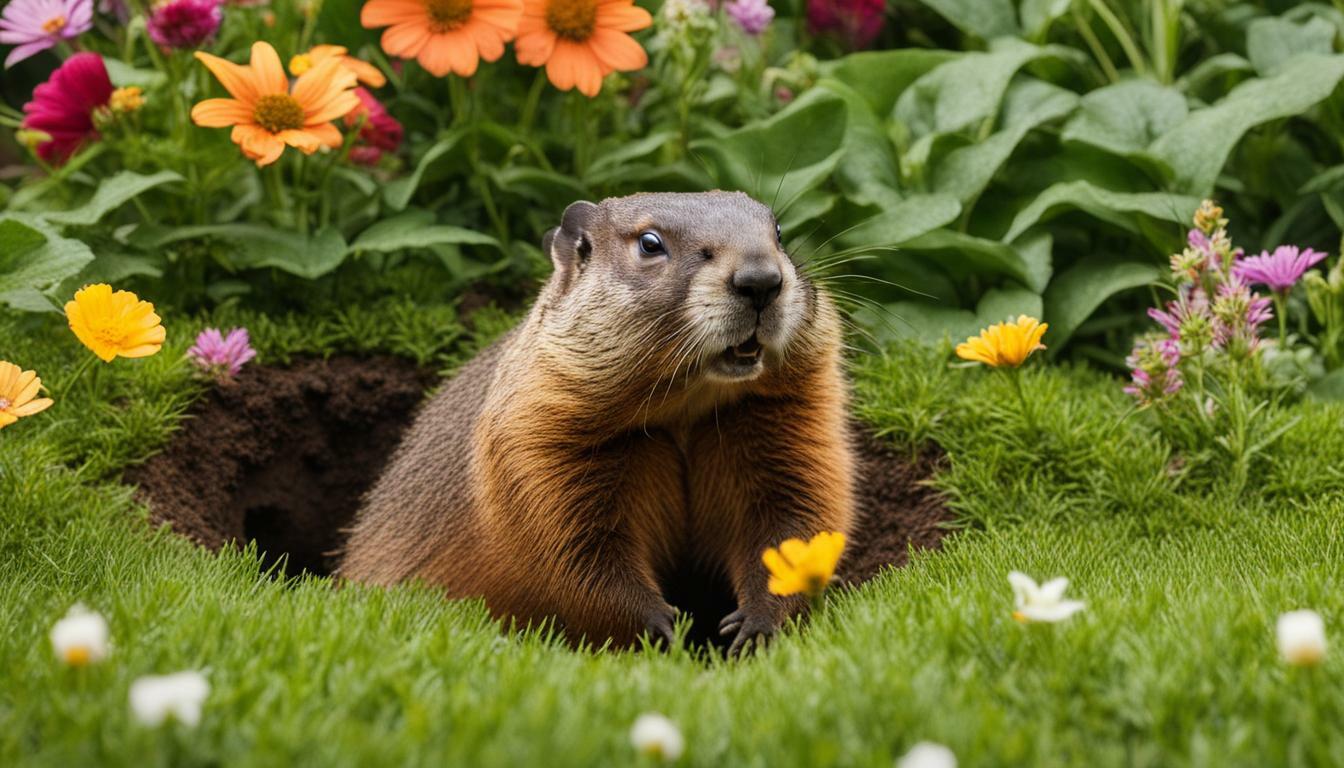Groundhogs, also known as woodchucks, are known for their burrowing and hole-digging behavior. They dig elaborate burrows that can measure up to 66 feet long and contain multiple chambers, exits, and levels. Groundhogs are solitary creatures and live alone in their burrows, only seeking each other out to mate. They dig burrows near plentiful food sources, such as farms and gardens, and like to build their burrows in covered areas for protection. Groundhogs have specialized claws for digging and can move up to 700 pounds of dirt when creating their burrows. It is important to take precautions to keep groundhogs away from your yard, such as filling in burrow entrances, removing vegetation and sources of cover, and using fences or barriers to block their access to gardens. Overall, groundhogs are capable of extensive hole-digging and burrow-building activities.
Key Takeaways:
- Groundhogs, also known as woodchucks, are skilled at burrowing and digging holes.
- They create complex burrows measuring up to 66 feet long, with multiple chambers, exits, and levels.
- Groundhogs prefer to live alone in their burrows, only coming together to mate.
- They choose burrow locations near abundant food sources and in covered areas for protection.
- With specialized claws, groundhogs can move up to 700 pounds of dirt when burrow-building.
Understanding Groundhog Burrows
Groundhogs dig elaborate burrows that can measure up to 66 feet long and contain multiple chambers, exits, and levels. These burrows are a testament to their impressive tunneling and excavation abilities. The intricate network of tunnels allows groundhogs to create a safe and secure underground habitat.
Within these burrows, groundhogs create various chambers for different activities. They have separate chambers for nesting, sleeping, storing food, and even bathroom areas. The chambers are interconnected by tunnels, which provide easy access to different parts of the burrow.
In addition to chambers, groundhogs also construct multiple exits in their burrows. This ensures that they have multiple escape routes in case of predators or other threats. The exits are usually hidden and blend seamlessly with the surrounding environment, providing the groundhogs with a way to quickly disappear from sight.
To further reinforce their burrows, groundhogs create levels within the tunnels. These levels help with water drainage, preventing the burrows from flooding. They also provide additional space for the groundhogs to move around and store their food. The levels are constructed using dirt and vegetation, creating mounds that can be seen above ground. These mounds, known as groundhog mounds, are a sign of the bustling activity happening beneath the surface.
| Key Features of Groundhog Burrows |
|---|
| Elaborate tunnels |
| Multiple chambers for different activities |
| Multiple hidden exits for easy escape |
| Levels for water drainage and additional space |
| Visible groundhog mounds above ground |
Choosing Burrow Locations
Groundhogs choose burrow locations based on factors such as proximity to food sources and the need for protection. These creatures are known for their habit of digging burrows near areas with plentiful food, such as farms and gardens. They are herbivores and prefer to reside close to their food supply, making it easy for them to access and forage for vegetation.
Additionally, groundhogs select locations that provide them with protection from predators and harsh weather conditions. They often build their burrows in covered areas, such as the edges of forests or along fences, to shield themselves from potential threats. The burrows act as safe havens where they can retreat to when they sense danger or adverse weather, ensuring their survival and well-being.
To get a better understanding of how groundhogs choose their burrow locations, refer to the table below:
| Factors for Choosing Burrow Locations | Importance |
|---|---|
| Proximity to food sources (farms, gardens, etc.) | High |
| Availability of covered areas for protection | High |
| Access to water sources | Moderate |
| Availability of suitable soil for burrow construction | Low |
Understanding the factors that influence groundhog burrow location choices can help you better manage their presence and take appropriate preventive measures to protect your yard or garden.
Impact on Your Yard
Groundhog holes can have a significant impact on the appearance and functionality of your yard. These holes, which can be quite large and deep, not only disrupt the smooth surface of your lawn but also pose a risk of tripping or spraining ankles. The presence of groundhog activity can make it challenging to maintain a well-kept yard, as their digging habits can damage vegetation and make it difficult to grow plants or maintain flower beds.
To prevent a groundhog infestation from causing further damage, it’s important to take proactive measures. One effective strategy is to fill in burrow entrances, which will discourage groundhogs from returning or digging new holes. Additionally, removing vegetation and sources of cover, such as tall grass or shrubs, can make your yard less attractive to groundhogs. Creating barriers, such as fences or wire mesh, can help block their access to gardens or other areas where they may cause damage.
It’s worth noting that groundhog infestations are not only limited to residential areas but can also affect farms and agricultural land. The burrows and tunnels they create can put livestock at risk of injury, and their feeding habits can cause damage to crops. Farmers and gardeners must be vigilant in implementing preventive measures to protect their land and livelihood from the impact of groundhog activity.
| Preventive Measures | Effectiveness |
|---|---|
| Filling in burrow entrances | High |
| Removing vegetation and cover | Moderate |
| Using fences or barriers | High |
Summary:
- Groundhog holes can have a significant impact on the appearance and functionality of your yard.
- To prevent further damage, fill in burrow entrances and remove vegetation and sources of cover.
- Using fences or barriers can help block groundhogs’ access to gardens or other vulnerable areas.
- Groundhog infestations can also affect farms and agricultural land, requiring additional preventive measures.
Dealing with Groundhog Activity
If you’re facing groundhog activity in your yard, there are several effective methods to handle the situation. These furry creatures can quickly become a nuisance, causing damage to your vegetation and creating unsightly holes in your yard. Here are some groundhog control methods that can help you reclaim your outdoor space.
1. Filling in Burrow Entrances
Start by identifying the entrances to the groundhog burrows in your yard. These are typically small openings that lead into their elaborate tunnel system. Use a shovel to fill the entrances with soil, packing it down firmly to prevent the groundhogs from re-entering. Make sure to check for multiple entrances and fill them all to effectively deter the groundhogs.
2. Removing Vegetation and Sources of Cover
Groundhogs are attracted to areas with abundant food sources and plenty of cover. To discourage them from frequenting your yard, remove any vegetation that they may find appealing, such as low-growing plants and vegetables. Additionally, clear away piles of debris and brush that could serve as hiding spots for these critters.
3. Using Fences or Barriers
Another effective method for controlling groundhog activity is to install fences or barriers around your garden or yard. Choose a sturdy material like wire mesh or wood that extends at least a foot below ground level and a few feet above. This will prevent the groundhogs from burrowing under or climbing over, effectively keeping them out of your desired areas.
4. Seeking Professional Help
If your groundhog problem persists despite your best efforts, it may be time to consider seeking professional assistance. Pest control experts have the knowledge and experience to effectively handle groundhog infestations. They can provide additional advice, implement advanced control methods, and ensure the safe removal of these critters from your property.
Remember, taking proactive measures to deter groundhogs from your yard is crucial to prevent further damage and maintain a well-kept outdoor space. By employing these groundhog control methods, you can reclaim your yard and enjoy a harmonious coexistence with these fascinating creatures.
Groundhog Digging Abilities
Groundhogs have impressive digging abilities, thanks to their specialized claws. These sharp and sturdy claws enable them to easily dig through the soil and create extensive burrows. They can move up to 700 pounds of dirt when constructing their underground homes. These burrows can stretch up to 66 feet in length and have multiple chambers, exits, and levels, providing groundhogs with ample space for living and raising their young.
When digging their burrows, groundhogs exhibit great efficiency and precision. They use their front paws and claws to excavate the soil, pushing it backward and away from the burrow entrance. As they dig deeper, they create a mound of dirt near the opening, which serves as a visible sign of groundhog activity. This mound helps in identifying the location of the burrow and monitoring groundhog presence.
Table 1: Groundhog Digging Abilities
| Ability | Description |
|---|---|
| Digging Depth | Groundhogs can dig burrows that extend several feet below the ground’s surface, providing them with protection from predators and extreme weather conditions. |
| Dirt Excavation | Groundhogs have the capability to move up to 700 pounds of dirt while constructing their burrows, reshaping the landscape in the process. |
| Burrow Structure | Groundhogs create complex burrow systems with multiple chambers, exits, and levels, ensuring the overall stability and functionality of their underground homes. |
Groundhogs’ digging abilities are not only remarkable but also necessary for their survival. These burrows provide crucial protection against predators, extreme temperatures, and harsh weather conditions. Additionally, their burrowing behavior helps groundhogs find food, as they often build their burrows near areas with abundant vegetation, such as farms and gardens.
Understanding groundhogs’ digging abilities is essential when considering how to deal with groundhog activity. By implementing preventive measures like filling in burrow entrances and removing sources of cover, we can discourage groundhogs from burrowing in our yards. Remember, it’s important to respect these creatures’ natural instincts while finding ways to coexist peacefully.
Preventive Measures
Taking preventive measures can help to discourage groundhogs from digging holes in your yard. By implementing a few simple strategies, you can protect your property and maintain a beautiful outdoor space.
First, it’s important to fill in any existing burrow entrances. Groundhogs are more likely to return to familiar locations, so by removing access points, you can deter them from reentering. Use soil or gravel to fill the holes, ensuring that the area is level and compacted. This will make it less inviting for groundhogs to dig again.
In addition to filling in burrows, it’s crucial to remove potential food sources and sources of cover. Remove fallen fruits and vegetables from your garden, as these can attract groundhogs. Trim back overgrown vegetation and clear away brush piles, as they create hiding spots for these burrowing creatures.
Creating physical barriers can also be effective in keeping groundhogs away. Install fences around your garden or yard, burying the bottom portion at least a foot underground to prevent digging. Consider using wire mesh or hardware cloth with small openings to make it difficult for groundhogs to squeeze through. Remember to check for any gaps or weak spots in the fence periodically to ensure its effectiveness.
| Preventive Measures for Groundhog Control |
|---|
| Fill in existing burrow entrances with soil or gravel |
| Remove fallen fruits and vegetables from your garden |
| Trim back overgrown vegetation and clear away brush piles |
| Install fences around your garden or yard |
While taking these preventive measures can be effective, it’s essential to monitor your yard regularly for any signs of groundhog activity. If you notice new burrows or evidence of digging, it may be necessary to reassess and reinforce your preventive strategies. By staying proactive, you can minimize the chances of groundhogs causing damage and keep your yard hole-free.
Groundhogs as Solitary Creatures
Groundhogs are solitary creatures, preferring to live alone in their burrows. They are not known to form social groups or colonies like some other rodent species. Instead, they establish their own territory and maintain a solitary lifestyle.
Within their burrows, groundhogs create multiple chambers for different purposes. These chambers serve as sleeping areas, nesting sites, and storage spaces for food. They also have separate entrances and exits, allowing the groundhog to move around discreetly and easily evade predators.
Groundhogs are also quite selective when it comes to choosing the locations for their burrows. They prefer areas near plentiful food sources, such as farms and gardens, as this ensures easy access to a steady supply of food. Additionally, they seek out areas with ample cover and protection, such as wooded areas or the edges of fields.
| Key Facts about Groundhogs as Solitary Creatures |
|---|
| Groundhogs live alone in their burrows. |
| They create multiple chambers within their burrows for different purposes. |
| Groundhogs prefer locations near abundant food sources and areas with ample cover and protection. |
Understanding the solitary nature of groundhogs can help us implement effective strategies to deal with their presence. By taking preventive measures, such as filling in burrow entrances, removing vegetation and sources of cover, and using fences or barriers to block their access to gardens, we can minimize the likelihood of groundhog infestation and the damage they can cause to our yards.
Conclusion
Groundhogs are indeed skilled at digging holes and creating elaborate burrows, which can have an impact on your yard if left unchecked. These furry creatures, also known as woodchucks, are known for their impressive burrowing abilities. They dig extensive burrows that can stretch up to 66 feet long and feature multiple chambers, exits, and levels. Their digging habits are not to be taken lightly, as they can significantly alter the landscape of your yard.
Living in solitary fashion, groundhogs prefer to keep to themselves in their burrows, only venturing out to find mates. They select burrow locations near areas that provide ample food sources, such as farms and gardens, ensuring a convenient food supply. Additionally, they gravitate towards covered areas for protection, making your yard an attractive spot for them to settle down.
Equipped with specialized claws, groundhogs are capable of moving up to an astonishing 700 pounds of dirt while constructing their burrows. This impressive digging ability showcases their determination to create a safe and comfortable home. However, the consequences of their digging can be detrimental to your yard, including damage to vegetation and the risk of tripping or injuring yourself due to their burrow entrances.
To prevent groundhog infestations and minimize the impact on your yard, it is crucial to take proactive measures. Filling in burrow entrances, removing vegetation and sources of cover, and employing fences or barriers to block their access to gardens are effective strategies for dealing with groundhog activity. By implementing these preventive measures, you can maintain a well-kept yard and discourage groundhogs from making their homes in your space.
In conclusion, groundhogs are skilled diggers that possess the ability to create elaborate burrows. Their digging habits can negatively impact your yard, but with the right precautions and preventive measures, you can mitigate these issues. By understanding their behavior and taking action, you can coexist peacefully with these industrious creatures while preserving the integrity of your yard.
FAQ
Do groundhogs dig holes?
Yes, groundhogs are known for their burrowing and hole-digging behavior. They dig elaborate burrows that can measure up to 66 feet long and contain multiple chambers, exits, and levels.
Why do groundhogs dig burrows?
Groundhogs dig burrows as their homes. They prefer to build their burrows near plentiful food sources, such as farms and gardens, and in covered areas for protection.
How much dirt can groundhogs move when digging their burrows?
Groundhogs have specialized claws for digging and can move up to 700 pounds of dirt when creating their burrows.
What can I do to keep groundhogs away from my yard?
To keep groundhogs away, you can fill in burrow entrances, remove vegetation and sources of cover, and use fences or barriers to block their access to gardens.
Are groundhogs social animals?
No, groundhogs are solitary creatures. They live alone in their burrows and only seek each other out for mating purposes.




